Sustainable Engineered Geopolymer Composites Utilizing Gamma-Irradiated PET and Graphene Nanoplatelets: Optimization and Performance Enhancement
Abstract
:1. Introduction
2. Experimental Program
2.1. Materials
2.1.1. Fly Ash
2.1.2. Activator
2.1.3. Aggregates
2.1.4. Gamma Irradiation of PET
2.1.5. Graphene Nanoplatelets
2.1.6. PVA Fibers
2.2. Experimental Design
2.2.1. Design of Experiments
2.2.2. Dispersion Method of Graphene Nanoplatelets in Water
2.3. Mixing Procedure Casting and Curing of Geopolymers
2.4. Test Methods
3. Results and Discussion
3.1. Slump Flow
3.2. Compressive Strength
3.3. Elastic Modulus
3.4. Flexural Properties:
3.4.1. First-Crack Strength and Flexural Strength of EGC
3.4.2. Flexural Toughness
3.4.3. Ductility Index
3.5. Drying Shrinkage
3.6. Multi-Objective Optimization
3.6.1. Methodology and Findings
3.6.2. Experimental Validation
4. Conclusions
- (1)
- Gamma radiation at 100 kGy fragment PET particles, increasing their crystallinity and enhancing the mechanical properties of EGC. This improvement is confirmed by FESEM imaging and X-ray diffraction analysis.
- (2)
- Using irradiated PET (IR-PET) reduces slump flow compared to untreated PET (R-PET). IR-PET restores compressive strength lost due to the smooth surface of R-PET, owing to its rough surface that improves bonding with the geopolymer matrix.
- (3)
- The addition of PET increases the ductility index significantly, with irradiated PET showing even greater enhancement compared to untreated PET. GNPs, however, tend to reduce ductility.
- (4)
- The synergistic effects of IR-PET and GNPs on EGC properties are effectively captured by 3D response surfaces and ANOVA models, which are statistically validated and useful for predicting desired responses.
- (5)
- PET exhibits significant potential for effective utilization in construction materials, particularly in EGC applications, when subjected to gamma irradiation and combined with GnPs. This transformation converts waste PET into construction materials with superior properties.
- (6)
- The optimization outcomes derived from the RSM prioritize the minimization of GNP usage and the maximization of IR-PET utilization. Experimental validation confirms that the optimal composite, which achieves maximum mechanical and post-crack properties while minimizing drying shrinkage, is achieved at a dosage of 26.4% IR-PET and 0.12% GNPs.
Author Contributions
Funding
Institutional Review Board Statement
Informed Consent Statement
Data Availability Statement
Acknowledgments
Conflicts of Interest
Appendix A. Validation of ANOVA Models
| Response | Standard Deviation | Mean | R2 | Predicted R2 | Adjusted R2 | Adequate Precision |
|---|---|---|---|---|---|---|
| Slump flow | 1.18 | 135.78 | 0.9939 | 0.9350 | 0.9837 | 28.656 |
| Compressive strength | 1.08 | 39.78 | 0.9846 | 0.8408 | 0.9590 | 19.106 |
| Elastic modulus | 0.5433 | 11.07 | 0.9802 | 0.8204 | 0.9472 | 16.616 |
| First-crack strength | 0.1366 | 7.23 | 0.9801 | 0.7572 | 0.9468 | 16.2395 |
| Flexural strength | 0.2640 | 8.03 | 0.9792 | 0.7739 | 0.9444 | 15.9798 |
| Flexural toughness | 0.5777 | 10.38 | 0.9906 | 0.8973 | 0.9749 | 23.3145 |
| Ductility index | 0.3952 | 10.28 | 0.9978 | 0.9744 | 0.9941 | 47.6867 |
| Drying shrinkage | 0.0147 | 0.2511 | 0.9842 | 0.8130 | 0.9580 | 17.826 |
| Response | Sum of Squares | Mean Square | F-Value | p-Value | Remarks |
|---|---|---|---|---|---|
| Slump flow | 683.36 | 136.67 | 97.75 | 0.0016 | Significant |
| Compressive strength | 226.03 | 45.21 | 38.44 | 0.0064 | Significant |
| Elastic modulus | 43.81 | 8.76 | 29.68 | 0.0093 | Significant |
| Flexural first-crack strength | 2.75 | 0.5502 | 29.50 | 0.0094 | Significant |
| Flexural strength | 9.82 | 1.96 | 28.18 | 0.0100 | Significant |
| Flexural toughness | 105.45 | 21.09 | 63.20 | 0.0031 | Significant |
| Ductility index | 212.42 | 42.48 | 271.99 | 0.0003 | Significant |
| Drying shrinkage | 0.0402 | 0.008 | 37.47 | 0.0066 | Significant |
References
- Scrivener, K.L.; John, V.M.; Gartner, E.M. Eco-Efficient Cements: Potential Economically Viable Solutions for a Low-CO2 Cement-Based Materials Industry. Cem. Concr. Res. 2018, 114, 2–26. [Google Scholar] [CrossRef]
- Sathiparan, N.; Anburuvel, A.; Selvam, V.V. Utilization of Agro-Waste Groundnut Shell and Its Derivatives in Sustainable Construction and Building Materials—A Review. J. Build. Eng. 2023, 66, 105866. [Google Scholar] [CrossRef]
- Zhang, P.; Zheng, Y.; Wang, K.; Zhang, J. A Review on Properties of Fresh and Hardened Geopolymer Mortar. Compos. Part B 2018, 152, 79–95. [Google Scholar] [CrossRef]
- Saravanakumar, R.; Elango, K.S.; Revathi, V.; Balaji, D. Influence of Aggressive Environment in Macro and Microstructural Properties of Bottom Ash Geopolymer Concrete. Sustainability 2024, 16, 1732. [Google Scholar] [CrossRef]
- Elemam, W.E.; Tahwia, A.M.; Abdellatief, M.; Youssf, O.; Kandil, M.A. Durability, Microstructure, and Optimization of High-Strength Geopolymer Concrete Incorporating Construction and Demolition Waste. Sustainability 2023, 15, 15832. [Google Scholar] [CrossRef]
- Ferrara, P.L.; La Noce, M.; Sciuto, G. Sustainability of Green Building Materials: A Scientometric Review of Geopolymers from a Circular Economy Perspective. Sustainability 2023, 15, 16047. [Google Scholar] [CrossRef]
- Ünal, M.T.; Gökçe, H.S.; Ayough, P.; Alnahhal, A.M.; Şimşek, O.; Nehdi, M.L. Nanomaterial and Fiber-Reinforced Sustainable Geopolymers: A Systematic Critical Review. Constr. Build. Mater. 2023, 404, 133325. [Google Scholar] [CrossRef]
- Rahman, A.S.; Jackson, P.; Radford, D.W. Improved Toughness and Delamination Resistance in Continuous Fiber Reinforced Geopolymer Composites via Incorporation of Nano-Fillers. Cem. Concr. Compos. 2020, 108, 103496. [Google Scholar] [CrossRef]
- Thakur, G.; Singh, Y.; Singh, R.; Prakash, C.; Saxena, K.K.; Pramanik, A.; Basak, A.; Subramaniam, S.; Waqas, R.M.; Zaman, S.; et al. Influence of Bentonite and Polypropylene Fibers on Geopolymer Concrete. Sustainability 2024, 16, 789. [Google Scholar] [CrossRef]
- Huo, W.; Zhu, Z.; Sun, H.; Ma, B.; Yang, L.; Rahmati, M.; Toufigh, V.; Tanyildizi, H.; Abdellatief, M.; Hassan, Y.M.; et al. Machine Learning Approaches to Predict Compressive Strength of Fly Ash-Based Geopolymer Concrete: A Comprehensive Review. Constr. Build. Mater. 2024, 16, 135519. [Google Scholar] [CrossRef]
- Qu, Y.; Li, W.; Wang, C.; Cao, H.; Zhou, R. Study on the Reinforced Properties of Geopolymer Fibers with a Sustainable Development Role. Sustainability 2024, 16, 6255. [Google Scholar] [CrossRef]
- Li, L.; Yan, C.; Zhang, N.; Farooqi, M.U.; Xu, S.; Deifalla, A.F. Flexural Fracture Parameters of Polypropylene Fiber Reinforced Geopolymer. J. Mater. Res. Technol. 2023, 24, 1839–1855. [Google Scholar] [CrossRef]
- Fantilli, A.P.; Mihashi, H.; Vallini, P. Multiple Cracking and Strain Hardening in Fiber-Reinforced Concrete under Uniaxial Tension. Cem. Concr. Res. 2009, 39, 1217–1229. [Google Scholar] [CrossRef]
- Wang, Z.; Sun, P.; Hu, Y.; Han, S. Crack Morphology Tailoring and Permeability Prediction of Polyvinyl Alcohol -Steel Hybrid Fiber Engineered Cementitious Composites. J. Clean. Prod. 2023, 383, 135335. [Google Scholar] [CrossRef]
- Li, Z.; Sheikh, M.N.; Feng, H.; Hadi, M.N.S. Mechanical Properties of Engineered Geopolymer Composite with Graphene Nanoplatelet. Ceram. Int. 2022, 48, 34915–34930. [Google Scholar] [CrossRef]
- Zhong, H.; Zhang, M. Engineered Geopolymer Composites: A State-of-the-Art Review. Cem. Concr. Compos. 2023, 135, 104850. [Google Scholar] [CrossRef]
- Dan Gavriletea, M. Environmental Impacts of Sand Exploitation. Analysis of Sand Market. Sustainability 2017, 9, 1118. [Google Scholar] [CrossRef]
- Abdellatief, M.; Adel, B.; Alanazi, H.; Tawfik, T.A. Multiscale Optimization Analysis of High Strength Alkali-Activated Concrete Containing Waste Medical Glass under Exposure to Carbonation and Elevated Temperatures. Dev. Built Environ. 2024, 19, 100492. [Google Scholar] [CrossRef]
- Wong, S.L.; Ngadi, N.; Abdullah, T.A.T.; Inuwa, I.M. Current State and Future Prospects of Plastic Waste as Source of Fuel: A Review. Renew. Sustain. Energy Rev. 2015, 50, 1167–1180. [Google Scholar] [CrossRef]
- Soni, V.; Dinh, D.A.; Poonia, K.; Kumar, R.; Singh, P.; Ponnusamy, V.K.; Selvasembian, R.; Singh, A.; Chaudhary, V.; Thakur, S.; et al. Upcycling of Polyethylene Terephthalate (PET) Plastic Wastes into Carbon-Based Nanomaterials: Current Status and Future Perspectives. Eur. Polym. J. 2024, 215, 113249. [Google Scholar] [CrossRef]
- Suraweera, S.M.D.V.; De Silva, S. Effect of Recycled Polyethylene Terephthalate (PET) Fibres on Fresh and Hardened Properties of Concrete: A Review. Int. J. Sustain. Eng. 2023, 16, 269–284. [Google Scholar] [CrossRef]
- Panara, V.; Bhonde, V.; Patel, S.; Jayswal, S.; Iyer, K.K.R.; Mungule, M. Effect of Waste PET Strips as Reinforcement in Concrete under Cyclic Loading. Clean. Mater. 2022, 6, 100147. [Google Scholar] [CrossRef]
- Parhi, S.K.; Patro, S.K. Application of R-Curve, ANCOVA, and RSM Techniques on Fracture Toughness Enhancement in PET Fiber-Reinforced Concrete. Constr. Build. Mater. 2024, 411, 134644. [Google Scholar] [CrossRef]
- Chong, B.W.; Shi, X. Meta-Analysis on PET Plastic as Concrete Aggregate Using Response Surface Methodology and Regression Analysis. J. Infrastruct. Preserv. Resil. 2023, 4, 2. [Google Scholar] [CrossRef]
- Abu-Saleem, M.; Zhuge, Y.; Hassanli, R.; Ellis, M.; Rahman, M.M.; Levett, P. Impact Resistance and Sodium Sulphate Attack Testing of Concrete Incorporating Mixed Types of Recycled Plastic Waste. Sustainability 2021, 13, 9521. [Google Scholar] [CrossRef]
- Saxena, R.; Gupta, T.; Sharma, R.K.; Chaudhary, S.; Jain, A. Assessment of Mechanical and Durability Properties of Concrete Containing PET Waste. Sci. Iran. 2020, 27, 1–9. [Google Scholar] [CrossRef]
- Deraman, R.; Nawi, M.N.M.; Yasin, M.N.; Ismail, M.H.; Ahmed, R.S.M.O.M. Polyethylene Terephthalate Waste Utilisation for Production of Low Thermal Conductivity Cement Sand Bricks. J. Adv. Res. Fluid Mech. Therm. Sci. 2021, 88, 117–136. [Google Scholar] [CrossRef]
- Dawood, A.O.; AL-Khazraji, H.; Falih, R.S. Physical and Mechanical Properties of Concrete Containing PET Wastes as a Partial Replacement for Fine Aggregates. Case Stud. Constr. Mater. 2021, 14, e00482. [Google Scholar] [CrossRef]
- Saxena, R.; Siddique, S.; Gupta, T.; Sharma, R.K.; Chaudhary, S. Impact Resistance and Energy Absorption Capacity of Concrete Containing Plastic Waste. Constr. Build. Mater. 2018, 176, 415–421. [Google Scholar] [CrossRef]
- Abdulkadir, I.; Mohammed, B.S.; Al-Yacouby, A.M.; Woen, E.L.; Tafsirojjaman, T. Tailoring an Engineered Cementitious Composite with Enhanced Mechanical Performance at Ambient and Elevated Temperatures Using Graphene Oxide and Crumb Rubber. J. Mater. Res. Technol. 2024, 28, 4508–4530. [Google Scholar] [CrossRef]
- Grigoriadis, K.; Bañuls-Ciscar, J.; Caverzan, A.; Negro, P.; Senaldi, C.; Ceccone, G. Use of Irradiated PET Plastic Waste for Partially Replacing Cement in Concrete? Waste Manag. 2023, 170, 193–203. [Google Scholar] [CrossRef]
- Khan, M.I.; Sutanto, M.H.; Khahro, S.H.; Zoorob, S.E.; Nur, N.I.; Al-Sabaeei, A.M.; Javed, Y. Fatigue Prediction Model and Stiffness Modulus for Semi-Flexible Pavement Surfacing Using Irradiated Waste Polyethylene Terephthalate-Based Cement Grouts. Coatings 2023, 13, 76. [Google Scholar] [CrossRef]
- Siddhartha; Aarya, S.; Dev, K.; Raghuvanshi, S.K.; Krishna, J.B.M.; Wahab, M.A. Effect of Gamma Radiation on the Structural and Optical Properties of Polyethyleneterephthalate (PET) Polymer. Radiat. Phys. Chem. 2012, 81, 458–462. [Google Scholar] [CrossRef]
- Schaefer, C.E.; Kupwade-Patil, K.; Ortega, M.; Soriano, C.; Büyüköztürk, O.; White, A.E.; Short, M.P. Irradiated Recycled Plastic as a Concrete Additive for Improved Chemo-Mechanical Properties and Lower Carbon Footprint. Waste Manag. 2018, 71, 426–439. [Google Scholar] [CrossRef]
- Imran Khan, M.; Sutanto, M.H.; Bin Napiah, M.; Zoorob, S.E.; Al-Sabaeei, A.M.; Rafiq, W.; Ali, M.; Memon, A.M. Investigating the Mechanical Properties and Fuel Spillage Resistance of Semi-Flexible Pavement Surfacing Containing Irradiated Waste PET Based Grouts. Constr. Build. Mater. 2021, 304, 124641. [Google Scholar] [CrossRef]
- Khan, M.I.; Sutanto, M.H.; Bin Napiah, M.; Khan, K.; Rafiq, W. Design Optimization and Statistical Modeling of Cementitious Grout Containing Irradiated Plastic Waste and Silica Fume Using Response Surface Methodology. Constr. Build. Mater. 2021, 271, 121504. [Google Scholar] [CrossRef]
- Alaskar, A.; Mahmood, M.S.; Nassar, R.U.D.; Zaid, O.; Althoey, F.; Arbili, M.M. Systematic Review on Geopolymer Composites Modified with Nanomaterials and Thin Films: Enhancing Performance and Sustainability in Construction. Constr. Build. Mater. 2023, 409. [Google Scholar] [CrossRef]
- Samuvel Raj, R.; Prince Arulraj, G.; Anand, N.; Kanagaraj, B.; Lubloy, E.; Naser, M.Z. Nanomaterials in Geopolymer Composites: A Review. Dev. Built Environ. 2023, 13, 100114. [Google Scholar] [CrossRef]
- Shilar, F.A.; Ganachari, S.V.; Patil, V.B.; Khan, T.M.Y.; Almakayeel, N.M.; Alghamdi, S. Review on the Relationship between Nano Modifications of Geopolymer Concrete and Their Structural Characteristics. Polymers 2022, 14, 1421. [Google Scholar] [CrossRef] [PubMed]
- Ranjbar, N.; Mehrali, M.; Mehrali, M.; Alengaram, U.J.; Jumaat, M.Z. Graphene Nanoplatelet-Fly Ash Based Geopolymer Composites. Cem. Concr. Res. 2015, 76, 222–231. [Google Scholar] [CrossRef]
- Li, Z.; Fei, M.E.; Huyan, C.; Shi, X. Nano-Engineered, Fly Ash-Based Geopolymer Composites: An Overview. Resour. Conserv. Recycl. 2021, 168, 105334. [Google Scholar] [CrossRef]
- Iqbal, H.W.; Hamcumpai, K.; Nuaklong, P.; Jongvivatsakul, P.; Likitlersuang, S.; Chintanapakdee, C.; Wijeyewickrema, A.C. Effect of Graphene Nanoplatelets on Engineering Properties of Fly Ash-Based Geopolymer Concrete Containing Crumb Rubber and Its Optimization Using Response Surface Methodology. J. Build. Eng. 2023, 75, 107024. [Google Scholar] [CrossRef]
- Mohammed, B.S.; Haruna, S.; Wahab, M.M.A.; Liew, M.S.; Haruna, A. Mechanical and Microstructural Properties of High Calcium Fly Ash One-Part Geopolymer Cement Made with Granular Activator. Heliyon 2019, 5, e02255. [Google Scholar] [CrossRef]
- Zahid, M.; Shafiq, N.; Razak, S.N.A.; Tufail, R.F. Investigating the Effects of NaOH Molarity and the Geometry of PVA Fibers on the Post-Cracking and the Fracture Behavior of Engineered Geopolymer Composite. Constr. Build. Mater. 2020, 265, 120295. [Google Scholar] [CrossRef]
- Hamidi, R.M.; Man, Z.; Azizli, K.A. Concentration of NaOH and the Effect on the Properties of Fly Ash Based Geopolymer. In Proceedings of the Procedia Engineering; Elsevier B.V.: Amsterdam, The Netherlands, 2016; Volume 148, pp. 189–193. [Google Scholar]
- Nematollahi, B.; Sanjayan, J.; Shaikh, F.U.A. Matrix Design of Strain Hardening Fiber Reinforced Engineered Geopolymer Composite. Compos. Part B Eng. 2016, 89, 253–265. [Google Scholar] [CrossRef]
- Khan, M.I.; Sutanto, M.H.; Khan, K.; Iqbal, M.; Bin Napiah, M.; Zoorob, S.E.; Klemeš, J.J.; Bokhari, A.; Rafiq, W. Effective Use of Recycled Waste PET in Cementitious Grouts for Developing Sustainable Semi-Flexible Pavement Surfacing Using Artificial Neural Network (ANN). J. Clean. Prod. 2022, 340, 130840. [Google Scholar] [CrossRef]
- Zhang, H.; Zhu, H.; Sun, R. Fabrication of Photocatalytic TiO2 Nanoparticle Film on PET Fabric by Hydrothermal Method. Text. Res. J. 2012, 82, 747–754. [Google Scholar] [CrossRef]
- Nematollahi, B.; Sanjayan, J.; Shaikh, F.U.A. Comparative Deflection Hardening Behavior of Short Fiber Reinforced Geopolymer Composites. Constr. Build. Mater. 2014, 70, 54–64. [Google Scholar] [CrossRef]
- Zahid, M.; Shafiq, N. Effects of Sand / Fly Ash and the Water / Solid Ratio on the Mechanical Properties of Engineered Geopolymer Composite and Mix Design Optimization. Minerals 2020, 10, 333. [Google Scholar] [CrossRef]
- Ghafari, E.; Costa, H.; Júlio, E. RSM-Based Model to Predict the Performance of Self-Compacting UHPC Reinforced with Hybrid Steel Micro-Fiber. Constr. Build. Mater. 2014, 66, 375–383. [Google Scholar] [CrossRef]
- Abdellatief, M.; Elrahman, M.A.; Elgendy, G.; Bassioni, G.; Tahwia, A.M. Response Surface Methodology-Based Modelling and Optimization of Sustainable UHPC Containing Ultrafine Fly Ash and Metakaolin. Constr. Build. Mater. 2023, 388, 131696. [Google Scholar] [CrossRef]
- Mohajeri, S.; Aziz, H.A.; Isa, M.H.; Zahed, M.A.; Adlan, M.N. Statistical Optimization of Process Parameters for Landfill Leachate Treatment Using Electro-Fenton Technique. J. Hazard. Mater. 2010, 176, 749–758. [Google Scholar] [CrossRef] [PubMed]
- Krishna, R.S.; Mishra, J.; Nanda, B.; Patro, S.K.; Adetayo, A.; Qureshi, T.S. The Role of Graphene and Its Derivatives in Modifying Different Phases of Geopolymer Composites: A Review. Constr. Build. Mater. 2021, 306, 124774. [Google Scholar] [CrossRef]
- Li, M.; Luo, R.; Qin, L.; Liu, H.; Duan, P.; Jing, W.; Zhang, Z.; Liu, X. High Temperature Properties of Graphene Oxide Modified Metakaolin Based Geopolymer Paste. Cem. Concr. Compos. 2022, 125, 104318. [Google Scholar] [CrossRef]
- Kangavar, M.E.; Lokuge, W.; Manalo, A.; Karunasena, W.; Frigione, M. Investigation on the Properties of Concrete with Recycled Polyethylene Terephthalate (PET) Granules as Fine Aggregate Replacement. Case Stud. Constr. Mater. 2022, 16, e00934. [Google Scholar] [CrossRef]
- Frigione, M. Recycling of PET Bottles as Fine Aggregate in Concrete. Waste Manag. 2010, 30, 1101–1106. [Google Scholar] [CrossRef]
- Lazorenko, G.; Kasprzhitskii, A.; Fini, E.H. Sustainable Construction via Novel Geopolymer Composites Incorporating Waste Plastic of Different Sizes and Shapes. Constr. Build. Mater. 2022, 324, 126697. [Google Scholar] [CrossRef]
- Ismail, Z.Z.; AL-Hashmi, E.A. Use of Waste Plastic in Concrete Mixture as Aggregate Replacement. Waste Manag. 2008, 28, 2041–2047. [Google Scholar] [CrossRef] [PubMed]
- Silva, R.V.; De Brito, J.; Dhir, R.K. Establishing a Relationship between Modulus of Elasticity and Compressive Strength of Recycled Aggregate Concrete. J. Clean. Prod. 2016, 112, 2171–2186. [Google Scholar] [CrossRef]
- Rahmani, E.; Dehestani, M.; Beygi, M.H.A.; Allahyari, H.; Nikbin, I.M. On the Mechanical Properties of Concrete Containing Waste PET Particles. Constr. Build. Mater. 2013, 47, 1302–1308. [Google Scholar] [CrossRef]
- Tay, C.H.; Norkhairunnisa, M. Mechanical Strength of Graphene Reinforced Geopolymer Nanocomposites: A Review. Front. Mater. 2021, 8, 661013. [Google Scholar] [CrossRef]
- González-Aviña, J.V.; Juárez-Alvarado, C.A.; Terán-Torres, B.T.; Mendoza-Rangel, J.M.; Durán-Herrera, A.; Rodríguez-Rodríguez, J.A. Influence of Fibers Distribution on Direct Shear and Flexural Behavior of Synthetic Fiber-Reinforced Self-Compacting Concrete. Constr. Build. Mater. 2022, 330, 127255. [Google Scholar] [CrossRef]
- Huang, D.; Liu, Z.; Lin, C.; Lu, Y.; Li, S. Effects and Mechanisms of Component Ratio and Cross-Scale Fibers on Drying Shrinkage of Geopolymer Mortar. Constr. Build. Mater. 2024, 411, 134299. [Google Scholar] [CrossRef]
- Negahban, E.; Bagheri, A.; Sanjayan, J. One-Year Study of Restrained Shrinkage and Creep Behaviours of Geopolymer Concrete. Constr. Build. Mater. 2023, 376, 131057. [Google Scholar] [CrossRef]
- Ferdosian, I.; Camões, A. Eco-Efficient Ultra-High Performance Concrete Development by Means of Response Surface Methodology. Cem. Concr. Compos. 2017, 84, 146–156. [Google Scholar] [CrossRef]
- Zahid, M.; Shafiq, N.; Isa, M.H.; Gil, L. Statistical Modeling and Mix Design Optimization of Fly Ash Based Engineered Geopolymer Composite Using Response Surface Methodology. J. Clean. Prod. 2018, 194, 483–498. [Google Scholar] [CrossRef]
- Subasi, A.; Sahin, B.; Kaymaz, I. Multi-Objective Optimization of a Honeycomb Heat Sink Using Response Surface Method. Int. J. Heat Mass Transf. 2016, 101, 295–302. [Google Scholar] [CrossRef]
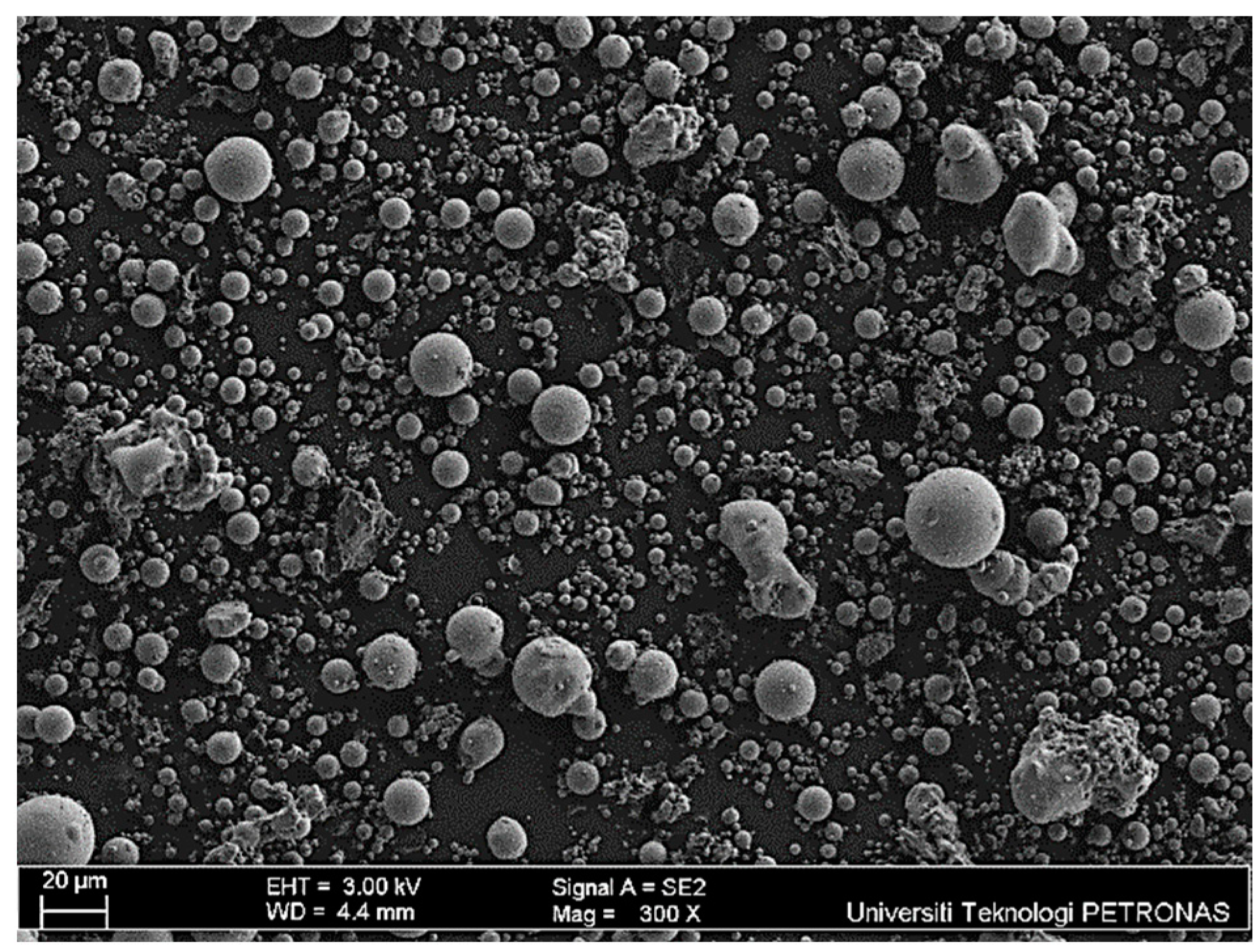
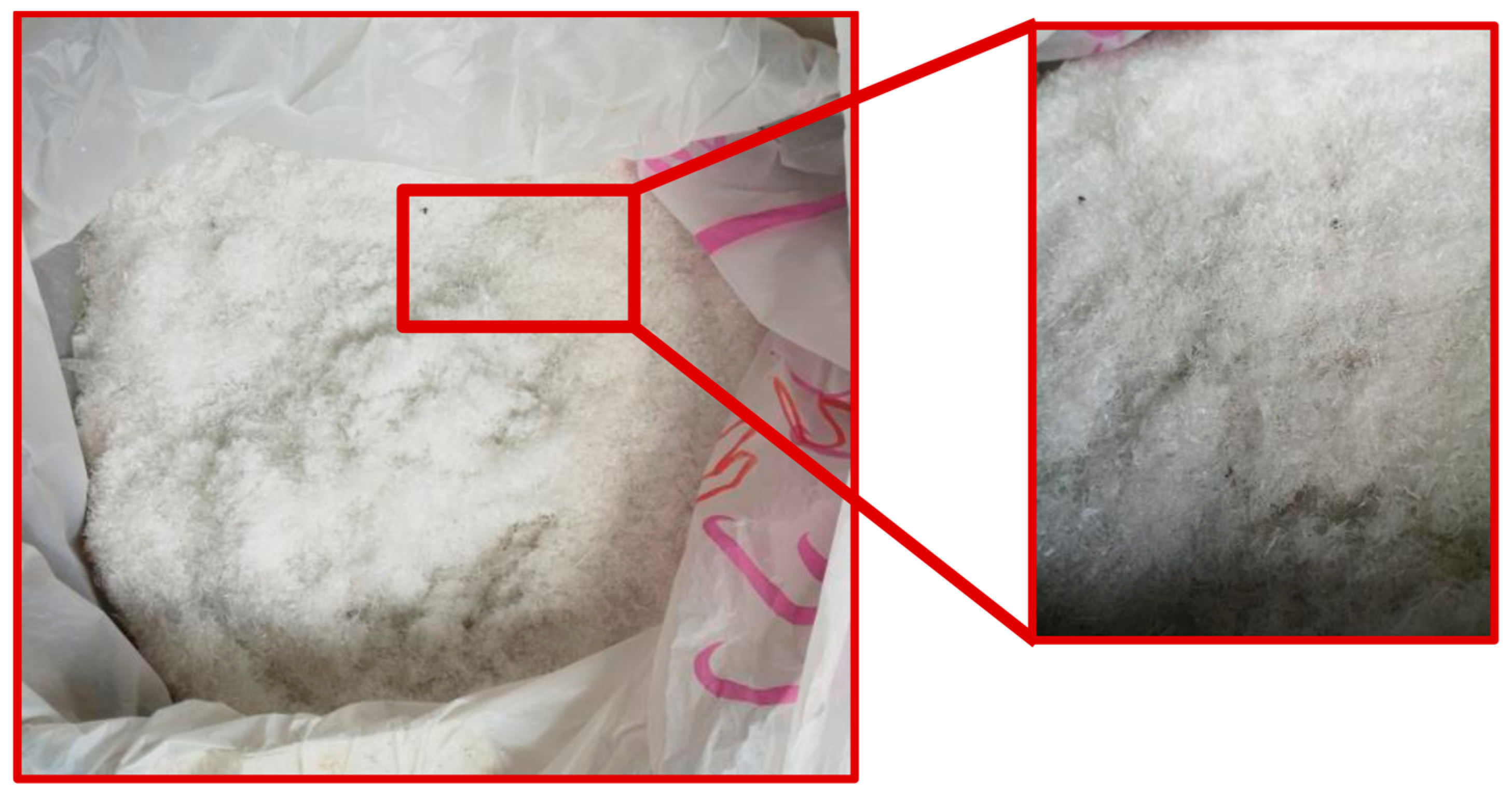
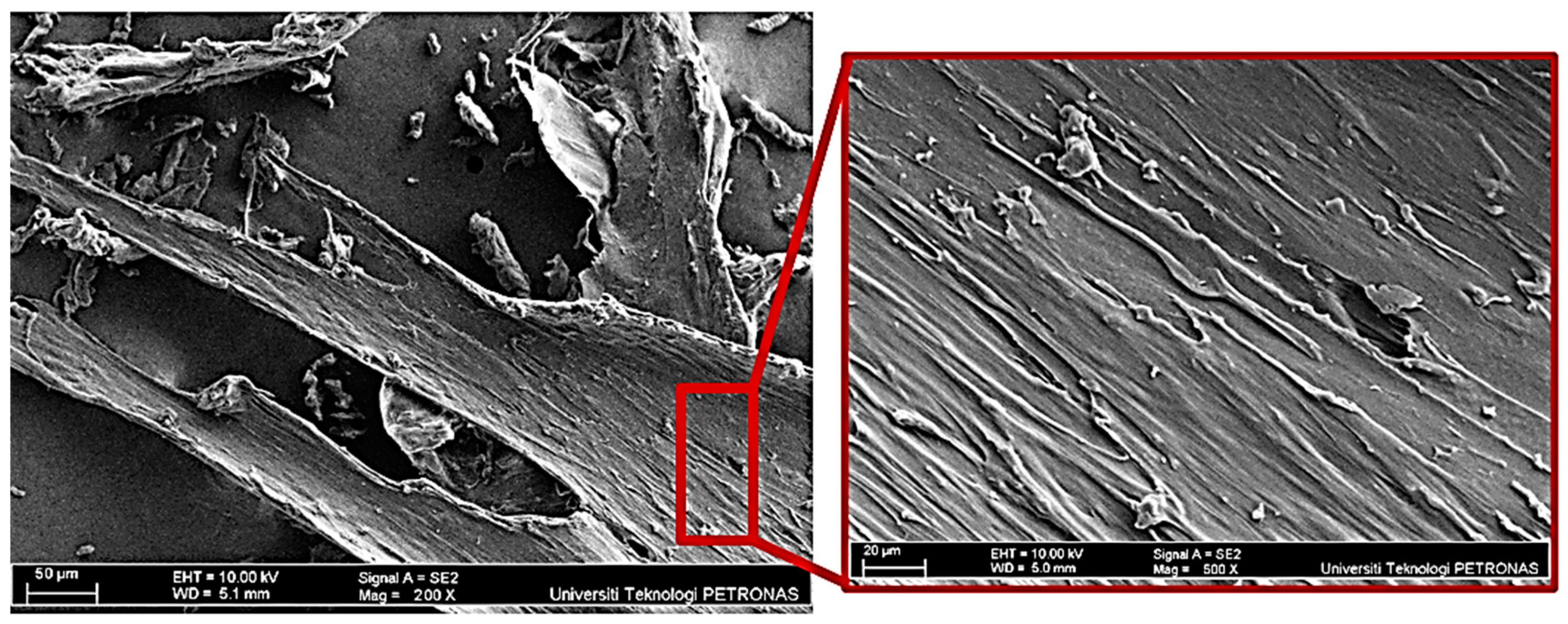









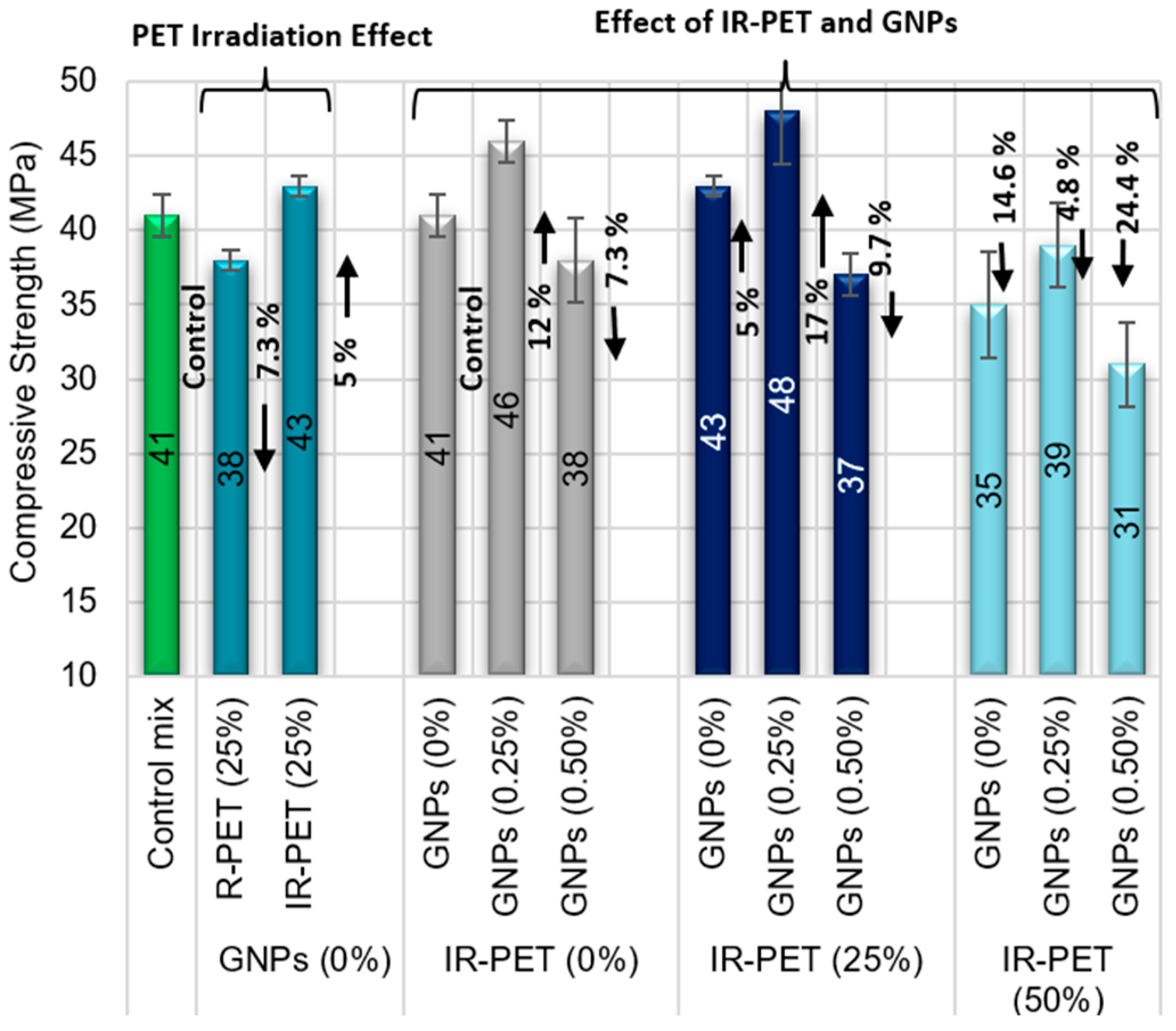


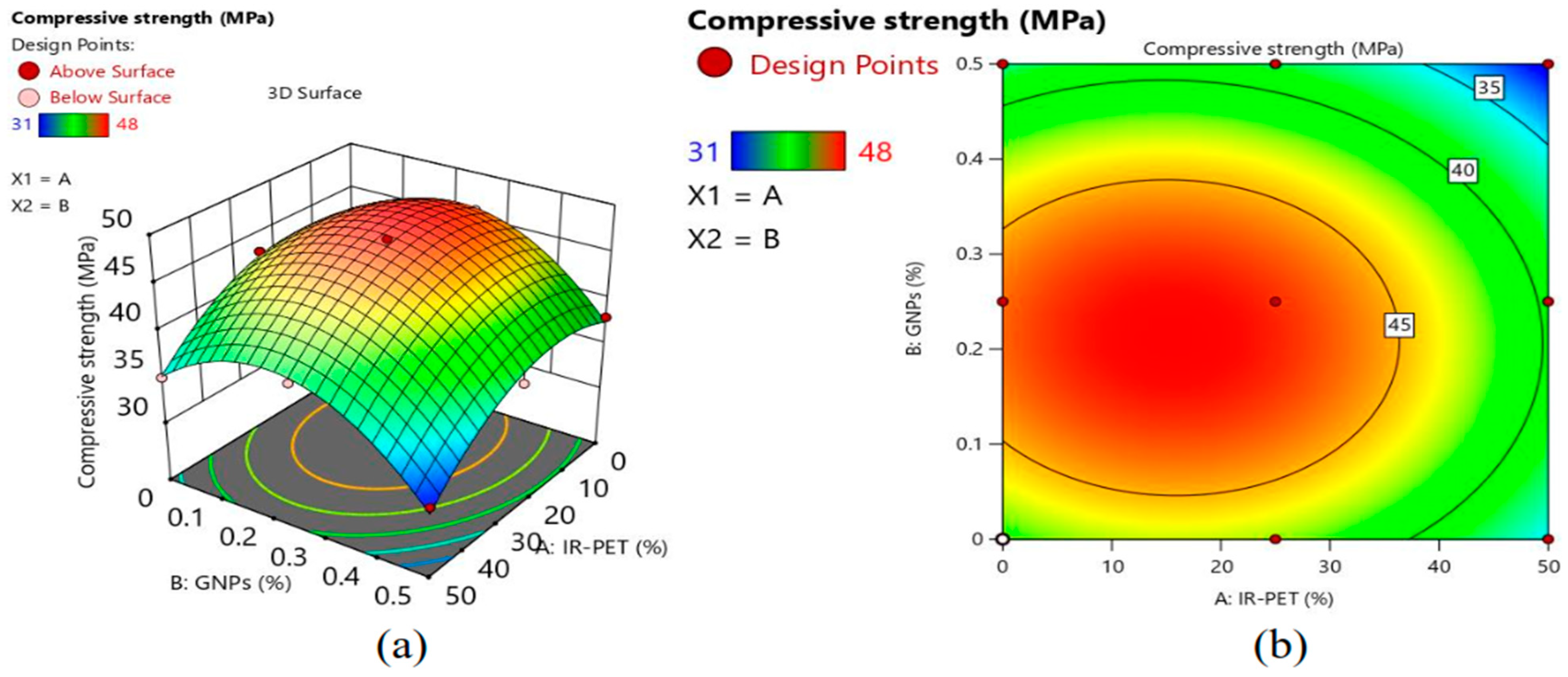

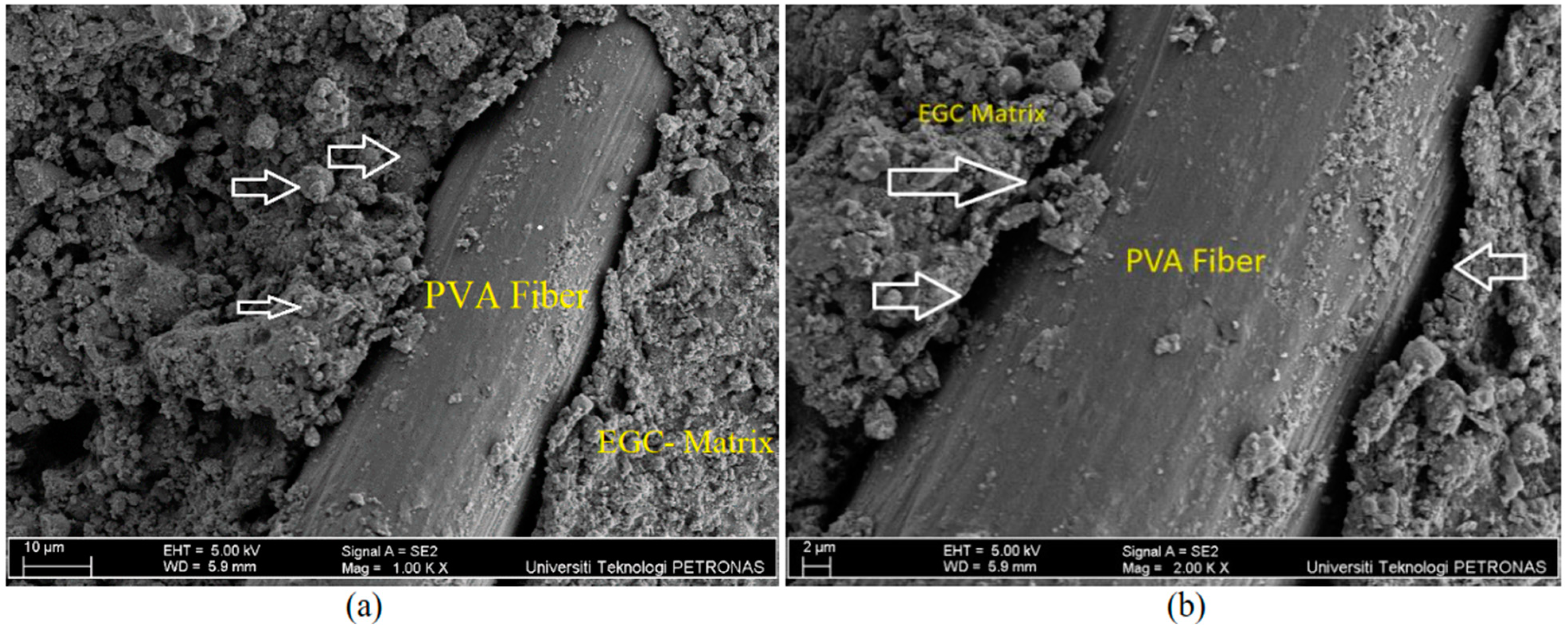

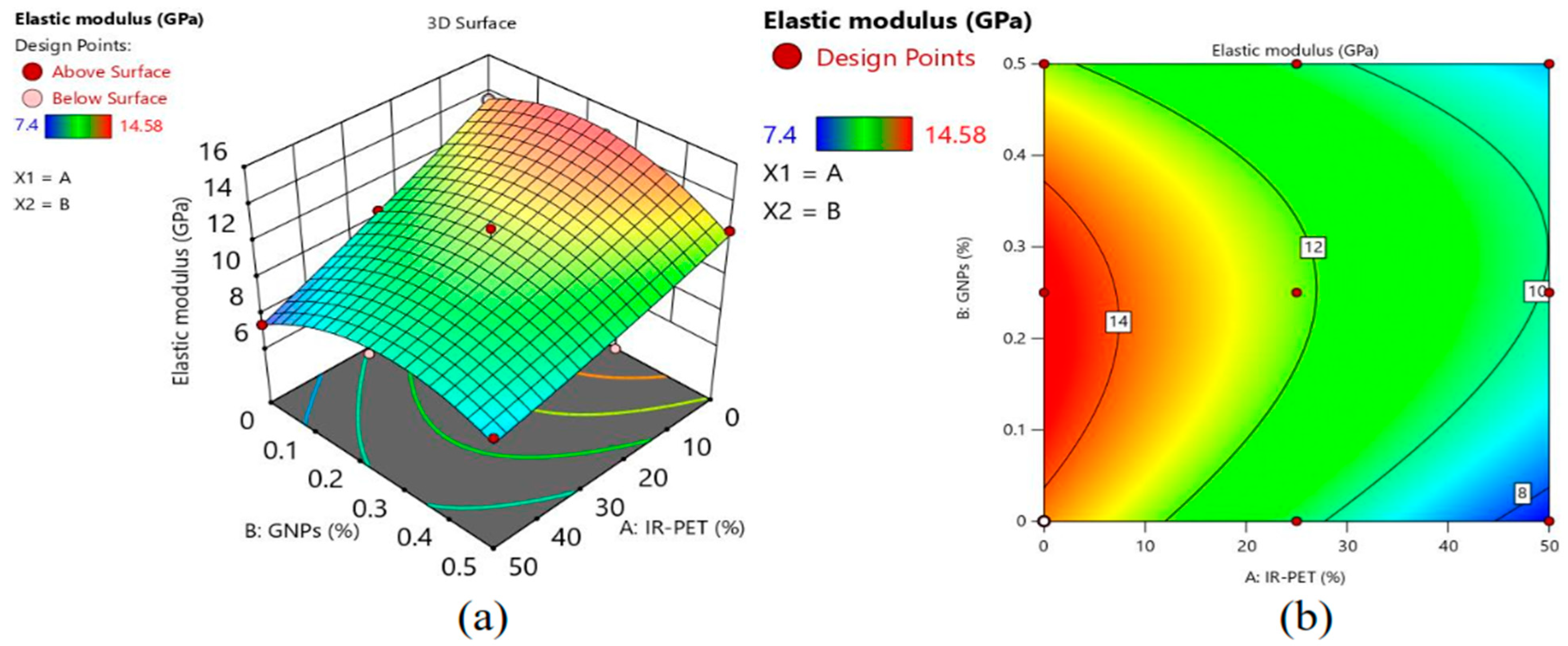


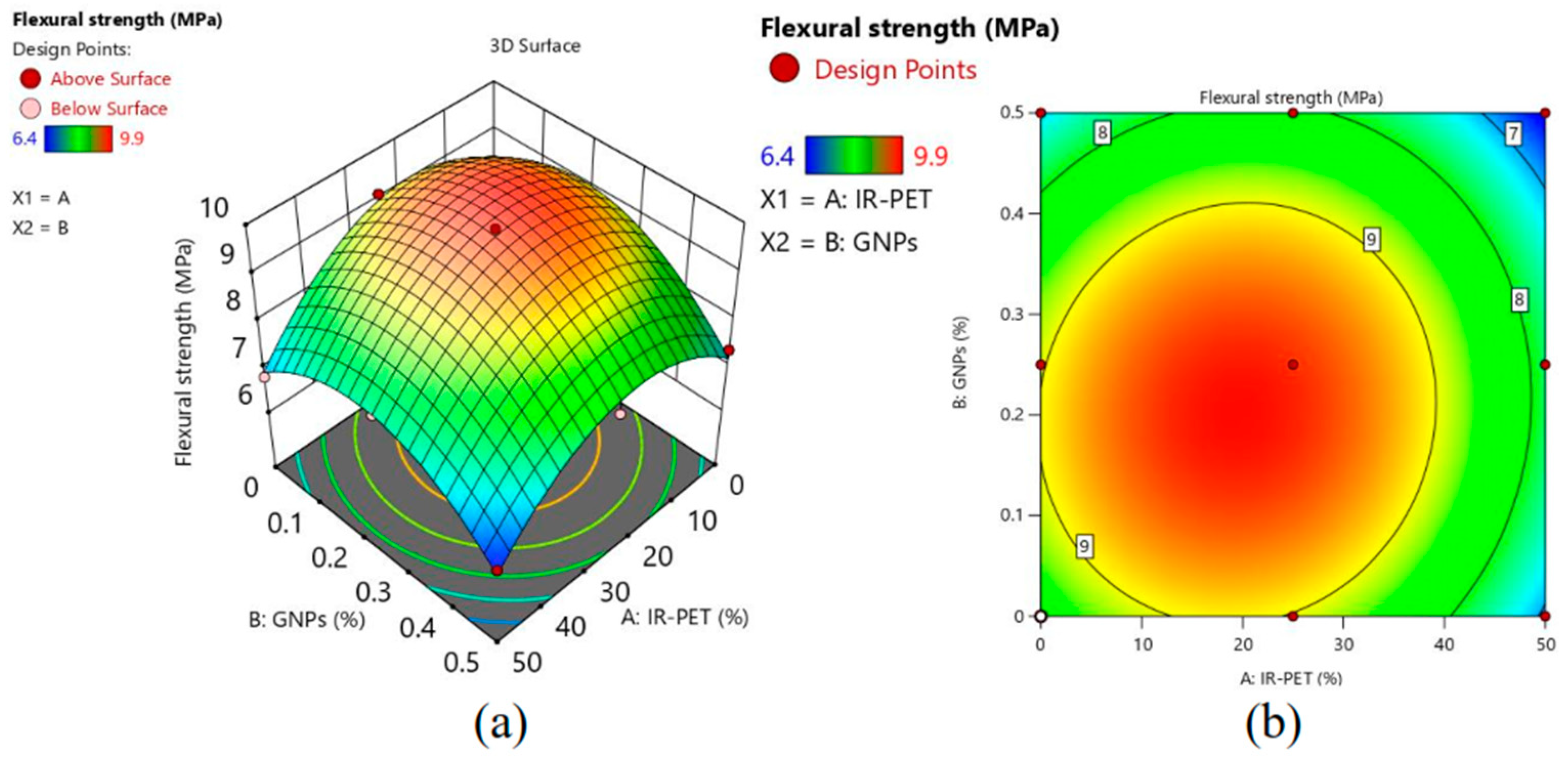
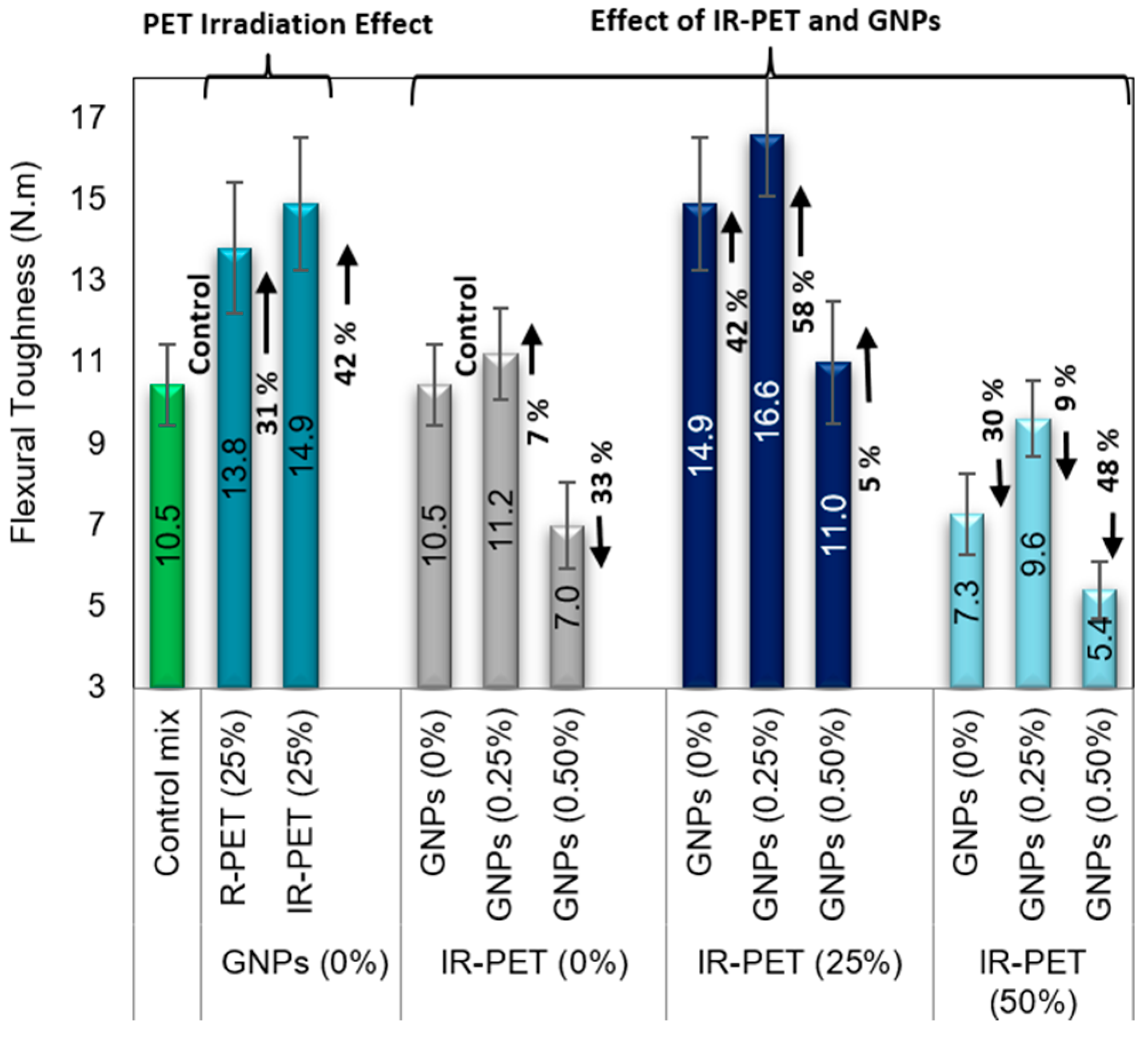


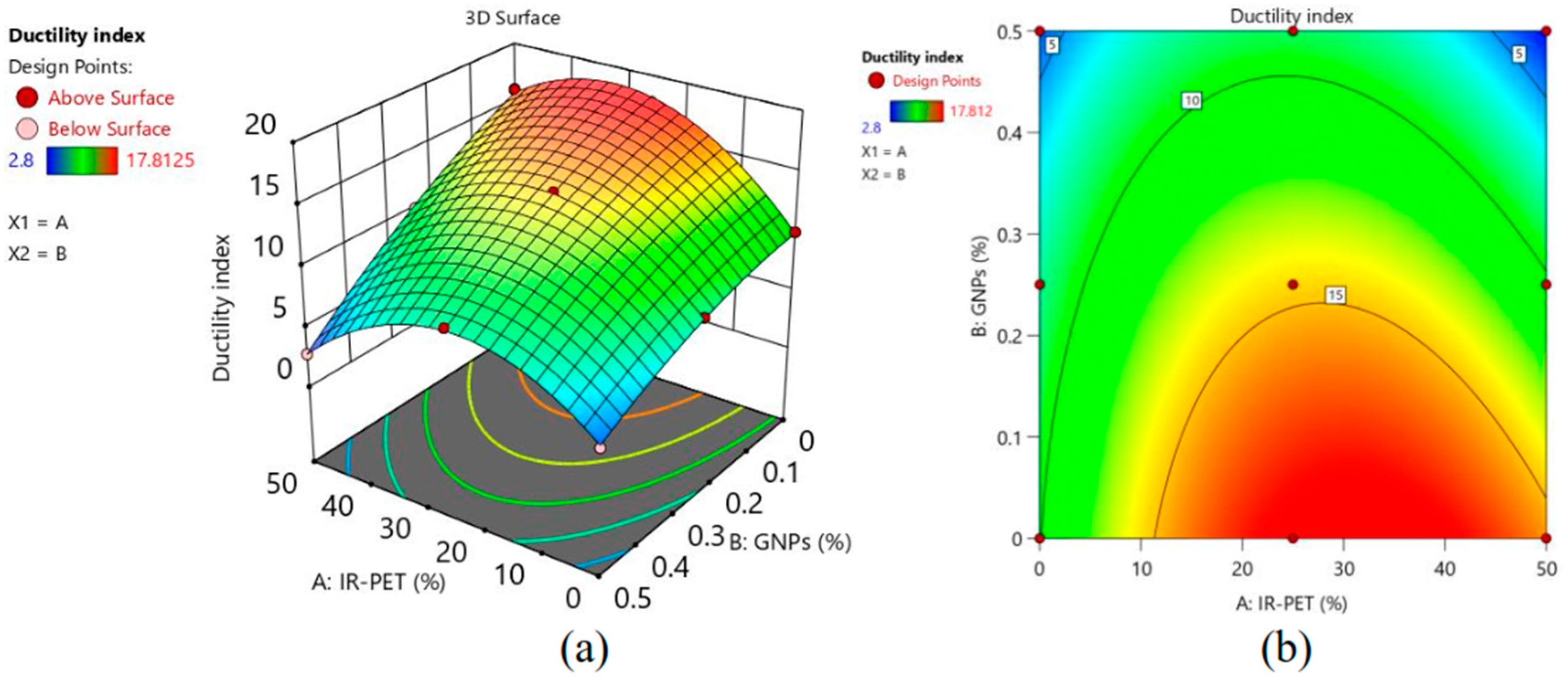
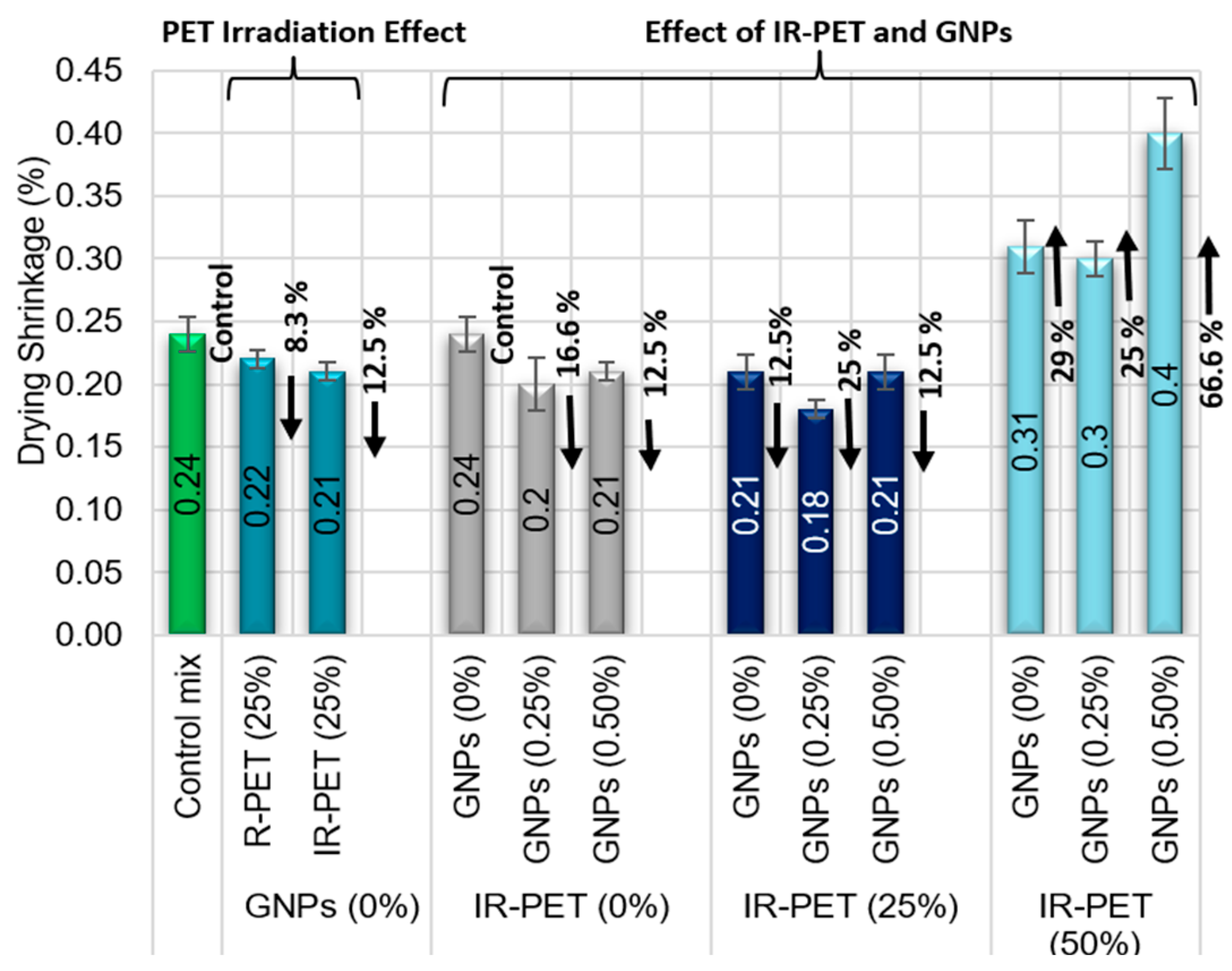


| SiO2 | Al2O3 | Fe2O3 | CaO | MgO | K2O | SO3 | TiO2 | P2O5 | Na2O | LOI |
|---|---|---|---|---|---|---|---|---|---|---|
| 34.5 | 12.8 | 23.6 | 19.0 | 1.27 | 2.08 | 1.49 | 1.46 | 1.11 | 0.16 | 2.6 |
| Sieve Size (µm) | 710 | 600 | 300 | 150 |
|---|---|---|---|---|
| Silica sand | 99.80 | 78.12 | 16.14 | 1.23 |
| R-PET | 95.50 | 80.40 | 24.10 | 2.40 |
| IR-PET | 99.10 | 85.30 | 34.80 | 5.20 |
| Designation | Surface Area (m3/g) | Diameter (µm) | Relative Gravity (g/cc) | Bulk Density (g/cm3) | Appearance |
|---|---|---|---|---|---|
| xGnP® | 300 | <2 | 2.0–2.25 | 0.2–0.4 g/cc | Black granule/powder |
| Fiber Type | Length (mm) | Diameter (mm) | Aspect Ratio (L/D) | Fiber Strength (MPa) | Youngs Modulus (GPa) | Density (g/cm3) |
|---|---|---|---|---|---|---|
| KURALON (RECS 15) | 8 | 0.04 | 300 | 1600 | 41 | 1.3 |
| Factor | Code | Levels | ||
|---|---|---|---|---|
| 0 | ||||
| IR-PET (%) | X1 | 0 | 25 | 50 |
| GnP (%) | X2 | 0 | 0.25 | 0.50 |
| Mix ID | Variables (%) | Constituent Materials | |||||
|---|---|---|---|---|---|---|---|
| R-PETa | IR-PET a | Fly Ash | Sand b | Na2SiO3 b | W/GP Solids b | PVA Fiber c | |
| Control | 0 | 0 | 1 | 0.3 | 0.12 | 0.24 | 0.02 |
| GR | 25 | 0 | 1 | 0.225 | 0.12 | 0.24 | 0.02 |
| GIR | 0 | 25 | 1 | 0.225 | 0.12 | 0.24 | 0.02 |
| Mix ID | Factors | Constituent Materials | |||||
|---|---|---|---|---|---|---|---|
| IR-PET a | GnP d | Fly Ash | Sand b | Na2SiO3 b | W/GP Solids b | PVA Fiber c | |
| Control | 0 | 0 | 1 | 0.3 | 0.12 | 0.24 | 0.02 |
| P0G0.25 | 0 | 0.25 | 1 | 0.3 | 0.12 | 0.24 | 0.02 |
| P0G0.5 | 0 | 0.50 | 1 | 0.3 | 0.12 | 0.24 | 0.02 |
| P25G0 | 25 | 0 | 1 | 0.225 | 0.12 | 0.24 | 0.02 |
| P25G0.25 | 25 | 0.25 | 1 | 0.225 | 0.12 | 0.24 | 0.02 |
| P25G0.50 | 25 | 0.50 | 1 | 0.225 | 0.12 | 0.24 | 0.02 |
| P50G0 | 50 | 0 | 1 | 0.15 | 0.12 | 0.24 | 0.02 |
| P50G0.25 | 50 | 0.25 | 1 | 0.15 | 0.12 | 0.24 | 0.02 |
| P50G0.50 | 50 | 0.50 | 1 | 0.15 | 0.12 | 0.24 | 0.02 |
| Test | Standard | Sample | |
|---|---|---|---|
| Shape | Size, mm | ||
| Mini-slump flow | ASTM C1437-15 | Truncated cone | 70 × 100 × 60 |
| Compressive strength | ASTM C109/C109M-16a | Cube | 50 × 50 × 50 |
| Elastic modulus | ASTM C 469-14 | Cylinder | 100 × 150 |
| Flexural strength | ASTM 1609-12 | Beam | 24 × 100 × 50 |
| Flexural toughness | ASTM 1609-12 | ||
| Ductility index | As recommended by Nematollahi [39]. | ||
| Drying shrinkage | ASTM C157/C157M-17 | Prism | 25 × 25 × 285 |
| Name of Factors and Response | Goal | Lower Limit | Upper Limit |
|---|---|---|---|
| IR-PET | Maximize | 0 | 50 |
| GNPs | Minimize | 0 | 0.5 |
| Slump flow | In range | 120 | 148 |
| Compressive strength | Maximize | 31 | 48 |
| Elastic modulus | Maximize | 2.8 | 17.8 |
| First-crack strength | In range | 6.2 | 8 |
| Flexural strength | Maximize | 6.4 | 9.9 |
| Flexural toughness | Maximize | 7.4 | 14.6 |
| Ductility index | Maximize | 2.8 | 17.8 |
| Drying shrinkage | Minimize | 0.18 | 0.4 |
| Factors (Variables) | Responses (EGC Properties) | ||||||||
|---|---|---|---|---|---|---|---|---|---|
| IR-PET | GNPs | (%) | CS (MPa) | E (GPa) | FT (N.m) | DI | FS (MPa) | DS(%) | Desirability |
| 26.4 | 0.12 | 143.4 | 46.3 | 11.5 | 16.1 | 16.8 | 9.6 | 0.18 | 0.806 |
| Response | (%) | CS (MPa) | E (GPa) | FT (N.m) | DI | FS (MPa) | DS (%) |
|---|---|---|---|---|---|---|---|
| Predicted | 143.4 | 46.3 | 11.5 | 16.1 | 16.8 | 9.6 | 0.18 |
| Experimental | 137.2 | 44.1 | 12 | 15.3 | 17.6 | 10.06 | 0.172 |
| Error (%) | 4.32 | 4.75 | 4.34 | 4.96 | 4.76 | 4.79 | 4.44 |
Disclaimer/Publisher’s Note: The statements, opinions and data contained in all publications are solely those of the individual author(s) and contributor(s) and not of MDPI and/or the editor(s). MDPI and/or the editor(s) disclaim responsibility for any injury to people or property resulting from any ideas, methods, instructions or products referred to in the content. |
© 2024 by the authors. Licensee MDPI, Basel, Switzerland. This article is an open access article distributed under the terms and conditions of the Creative Commons Attribution (CC BY) license (https://creativecommons.org/licenses/by/4.0/).
Share and Cite
Zahid, M.; Abbas, Y.M.; Shafiq, N.; Khan, M.I.; Ismail, F.I. Sustainable Engineered Geopolymer Composites Utilizing Gamma-Irradiated PET and Graphene Nanoplatelets: Optimization and Performance Enhancement. Sustainability 2024, 16, 7455. https://doi.org/10.3390/su16177455
Zahid M, Abbas YM, Shafiq N, Khan MI, Ismail FI. Sustainable Engineered Geopolymer Composites Utilizing Gamma-Irradiated PET and Graphene Nanoplatelets: Optimization and Performance Enhancement. Sustainability. 2024; 16(17):7455. https://doi.org/10.3390/su16177455
Chicago/Turabian StyleZahid, Muhammad, Yassir M. Abbas, Nasir Shafiq, Mohammad Iqbal Khan, and Fouad Ismail Ismail. 2024. "Sustainable Engineered Geopolymer Composites Utilizing Gamma-Irradiated PET and Graphene Nanoplatelets: Optimization and Performance Enhancement" Sustainability 16, no. 17: 7455. https://doi.org/10.3390/su16177455








